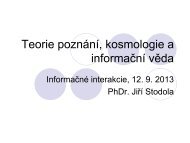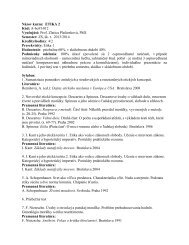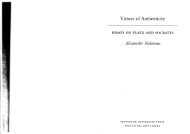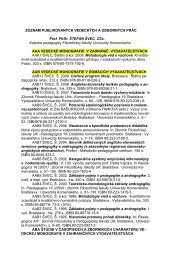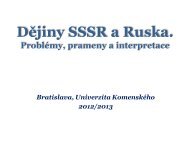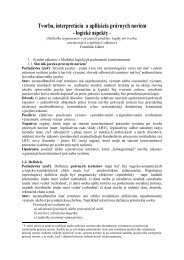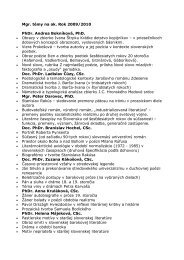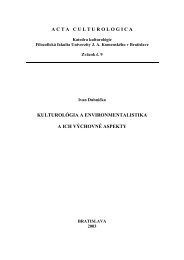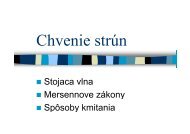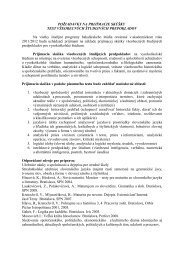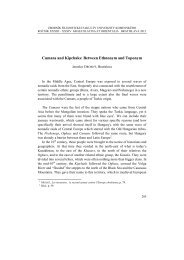Department of British and American Studies at the - Univerzita ...
Department of British and American Studies at the - Univerzita ...
Department of British and American Studies at the - Univerzita ...
You also want an ePaper? Increase the reach of your titles
YUMPU automatically turns print PDFs into web optimized ePapers that Google loves.
Dialect in Fiction<br />
Ján Vilikovský<br />
Comenius University, Br<strong>at</strong>islava<br />
Dialect is one <strong>of</strong> <strong>the</strong> oldest <strong>and</strong> most frequently used non-st<strong>and</strong>ard linguistic elements<br />
to be found in cre<strong>at</strong>ive liter<strong>at</strong>ure.<br />
This paper deals primarily with <strong>the</strong> use <strong>of</strong> regional or urban dialects; social dialects,<br />
slang, argot &c. are <strong>of</strong> marginal interest only.<br />
Dialects, <strong>of</strong> course, are <strong>the</strong> elements entering into <strong>the</strong> form<strong>at</strong>ion <strong>of</strong> a n<strong>at</strong>ional<br />
language, ei<strong>the</strong>r by one <strong>of</strong> <strong>the</strong>m <strong>at</strong>taining a dominant position (as in Slovak), or by<br />
amalgam<strong>at</strong>ion. The classical Greek koiné is <strong>the</strong> best known case <strong>of</strong> <strong>the</strong> l<strong>at</strong>ter, but <strong>the</strong>re are<br />
o<strong>the</strong>r examples <strong>of</strong> this process – e.g. <strong>the</strong> Danish-Norwegian koiné, which became <strong>the</strong> basis <strong>of</strong><br />
Norwegian Bokmål, Friulian in Italy (Furlan), <strong>and</strong> some scholars would also include Scots<br />
English or Quebec French under this heading.<br />
Obviously, this process is gradual <strong>and</strong> slow. Never<strong>the</strong>less, its result is <strong>the</strong> existence <strong>of</strong><br />
two levels <strong>of</strong> language – <strong>the</strong> first being <strong>the</strong> st<strong>and</strong>ard or codified variety, <strong>and</strong> <strong>the</strong> second a<br />
subordin<strong>at</strong>e one, covering a number <strong>of</strong> usages. As we know from semiotics, if this distinction<br />
is to be used for literary purposes, <strong>the</strong>re has to be a definite <strong>and</strong> well-marked opposition<br />
between <strong>the</strong> two levels, <strong>and</strong> in <strong>the</strong> case <strong>of</strong> <strong>the</strong> language <strong>of</strong> liter<strong>at</strong>ure <strong>the</strong>re must exist<br />
system<strong>at</strong>ic <strong>and</strong> unambiguous conventions allowing a ready identific<strong>at</strong>ion <strong>of</strong> <strong>the</strong> various forms.<br />
The primary functions <strong>of</strong> dialect in a literary work are localis<strong>at</strong>ion <strong>and</strong><br />
characteris<strong>at</strong>ion. Localis<strong>at</strong>ion serves to identify a character or action with a certain<br />
neighbourhood or milieu, placing <strong>the</strong>m in a given space through linguistic means, an<br />
associ<strong>at</strong>ion or allusion, instead <strong>of</strong> explicit geographical design<strong>at</strong>ion. Characteris<strong>at</strong>ion is a<br />
more complex process, since dialect is used here both as an <strong>at</strong>tribute <strong>of</strong> belonging to a certain<br />
class or group, <strong>and</strong> as a symbolic means exploiting our tendency to generalise <strong>and</strong> associ<strong>at</strong>e<br />
certain types <strong>of</strong> behaviour with particular properties. Moreover, book learning stigm<strong>at</strong>izes <strong>the</strong><br />
use <strong>of</strong> non-st<strong>and</strong>ard linguistic elements <strong>and</strong> uses <strong>the</strong>m as a means <strong>of</strong> foregrounding<br />
(estrangement). We see th<strong>at</strong> this is a multipurpose approach <strong>of</strong>fering numerous possibilities,<br />
depending on <strong>the</strong> authorial intent.<br />
Slovak <strong>Studies</strong> in English, Vol. 3, 2011 – Identity in Intercultural Communic<strong>at</strong>ion<br />
HONORARY CONTRIBUTIONS<br />
Non-st<strong>and</strong>ard <strong>and</strong> dialect elements appear in literary language from very early times.<br />
As far back as <strong>the</strong> first century B.C. we find, side by side with classical Ciceronian L<strong>at</strong>in,<br />
35



